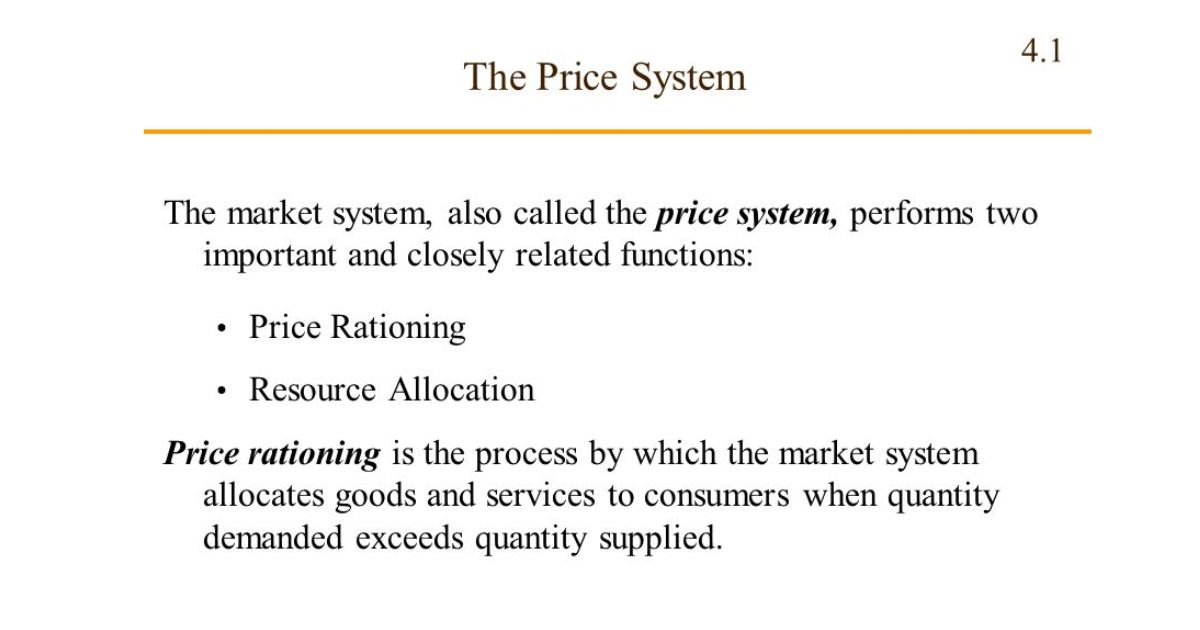In this article, we will explore the nuances and distinctions between rationing and a price-based market system. Through an unbiased and analytical lens, we will delve into the historical context, government intervention, allocation mechanisms, and their impact on consumer behavior and decision-making.
We will discuss the efficiency and equity considerations associated with both systems. Finally, we will examine potential alternatives and future prospects for rationing and market pricing. Join us as we navigate this fascinating topic and uncover the complexities of resource allocation.
Key Takeaways
- Rationing and price-based market systems originated in the early 20th century to address scarcity and economic instability, with government intervention playing a crucial role in both systems.
- Government intervention in rationing involves setting fixed prices for essential goods to ensure affordability and equitable distribution, while in market-based systems, the focus is on market regulation to prevent monopolistic practices and protect consumer rights.
- Rationing systems use non-price mechanisms like first-come, first-served, priority based on need or merit, or a lottery system to ensure fairness and equal access to resources, while market pricing relies on the price mechanism determined by supply and demand.
- Balancing government intervention and market forces is essential for maximum efficiency in rationing systems, and exploring alternative approaches, such as advanced technology and data analytics, can enhance resource allocation.
Historical Context of Rationing and Price-Based Market Systems
The historical context of rationing and price-based market systems can be traced back to the early 20th century when governments began implementing measures to control the distribution of goods and services during times of scarcity or economic instability. Government intervention became necessary to ensure that essential resources were allocated fairly and efficiently.
Rationing systems were put in place to limit the consumption of certain goods, such as food and fuel, based on predetermined quotas. This approach aimed to prevent hoarding and ensure that everyone had access to essential items. On the other hand, price-based market systems rely on the forces of supply and demand to determine the allocation of goods.
Consumer behavior plays a crucial role in influencing market prices, as individuals make choices based on their preferences and willingness to pay. Understanding the historical context of these systems is essential to comprehend the role of government intervention in rationing and market pricing.
The Role of Government Intervention in Rationing and Market Pricing
Government intervention plays a significant role in both rationing and market pricing systems. When it comes to pricing, the government can implement policies such as price controls, subsidies, or taxes to influence the cost of goods and services.
In terms of rationing, the government can establish criteria and allocate resources based on societal needs or priorities. These interventions aim to regulate markets and ensure fairness, efficiency, and access to essential goods and services.
Government’s Impact on Pricing
Through its intervention, the government plays a crucial role in shaping pricing dynamics in both rationing and market-based systems. In a rationing system, the government’s influence is more direct, as it determines the allocation of scarce resources based on a set of criteria.
This includes setting fixed prices for essential goods, such as food and fuel, to ensure affordability and equitable distribution. On the other hand, in a market-based system, the government’s role is more focused on market regulation. This involves implementing policies to prevent monopolistic practices, ensuring fair competition, and protecting consumer rights.
By establishing regulations and enforcing them, the government aims to create a level playing field and maintain transparency in pricing. This transition into discussing the efficiency of rationing systems highlights the importance of government intervention in ensuring an equitable distribution of resources.
Efficiency of Rationing Systems
Maximizing efficiency while ensuring equitable resource allocation, government intervention plays a vital role in rationing systems and market pricing. Rationing systems are often implemented during times of scarcity or emergency, when allocation efficiency becomes crucial.
In these situations, government intervention helps to ensure that resources are distributed fairly and efficiently among the population. By setting limits and guidelines for resource allocation, the government aims to prevent hoarding and prioritize essential needs. However, the effectiveness of rationing systems depends on various factors, including consumer behavior. Understanding consumer preferences and demand patterns is essential for designing an efficient rationing system.
Government intervention in market pricing can also impact efficiency. Price controls and regulations can distort market signals and lead to inefficiencies, potentially resulting in shortages or surpluses. Therefore, finding the right balance between government intervention and market forces is crucial for achieving maximum efficiency in rationing systems.
Allocation Mechanisms in Rationing Versus Market Pricing
One important aspect to consider when comparing rationing and market pricing is the various allocation mechanisms employed in each system. Rationing systems typically use non-price mechanisms to distribute resources, while market pricing relies on the price mechanism to allocate goods and services.
In a rationing system, allocation mechanisms can include methods such as first-come, first-served, priority based on need or merit, or a lottery system. These mechanisms aim to ensure fairness and equal access to resources, regardless of an individual’s ability to pay.
On the other hand, market pricing relies on the forces of supply and demand to determine resource distribution. Prices fluctuate based on the scarcity or abundance of a particular good or service, effectively allocating resources to those who are willing and able to pay the market price.
To compare and contrast these allocation mechanisms, let’s look at a table:
| Allocation Mechanism | Rationing | Market Pricing |
|---|---|---|
| First-come, first-served | Yes | No |
| Priority based on need or merit | Yes | No |
| Lottery system | Yes | No |
| Determined by supply and demand | No | Yes |
Impact on Consumer Behavior and Decision-Making
The impact on consumer behavior and decision-making differs significantly between rationing and a price-based market system. In a rationing system, consumer preferences may not play a significant role as allocation is based on predetermined criteria such as age, need, or priority.
Consumers may have limited options and may need to accept the available choices regardless of their personal preferences. On the other hand, in a price-based market system, consumer preferences are crucial as individuals have the freedom to choose based on their own preferences and budgets. Market competition also plays a role in influencing consumer decision-making.
Different sellers offer a variety of products or services, and consumers can make choices based on quality, price, and other factors. This dynamic market environment gives consumers more power and flexibility in their decision-making. Transitioning to the subsequent section, it is also important to consider the efficiency and equity considerations in rationing and market pricing.
Efficiency and Equity Considerations in Rationing and Market Pricing
Several factors need to be taken into account when considering the efficiency and equity considerations in rationing and market pricing. Efficiency considerations involve assessing the ability of a system to allocate resources optimally, while equity considerations focus on ensuring fairness and equal distribution of resources.
| Efficiency Considerations | Equity Considerations |
|---|---|
| – Allocating resources based on prices allows market forces to determine the most efficient allocation. | – Rationing systems can ensure that essential goods and services are distributed fairly, regardless of an individual’s ability to pay. |
| – Price signals encourage producers to increase supply in response to high demand, improving overall efficiency. | – Rationing can prevent hoarding and ensure that everyone has access to necessary goods during times of scarcity. |
| – Market pricing provides incentives for innovation and efficient resource allocation through competition. | – Rationing can prioritize vulnerable populations or promote social goals, such as reducing carbon emissions. |
Efficiency and equity considerations are essential in designing systems that strike a balance between optimizing resource allocation and ensuring fairness. By understanding the advantages and limitations of both rationing and market pricing, policymakers can make informed decisions that promote efficiency and equity in resource allocation.
Future Prospects and Potential Alternatives to Rationing and Market Pricing
As societies continue to grapple with the challenges of resource allocation, exploring innovative distribution strategies becomes crucial. This entails considering alternative approaches to rationing and market pricing that can potentially address the efficiency and equity concerns associated with both systems.
By examining the impact of these strategies on resource allocation, policymakers can evaluate their viability and potential to create more inclusive and sustainable economic systems.
Innovative Distribution Strategies
One potential alternative to both rationing and market pricing is the adoption of a dynamic distribution model that utilizes advanced technology and data analytics. This innovative approach takes into account consumer preferences and aims to optimize the allocation of resources.
By analyzing vast amounts of data, businesses can gain insights into individual consumer behavior and tailor their distribution strategies accordingly. This can lead to more efficient and personalized delivery methods, such as same-day or on-demand services.
The use of advanced technology, such as artificial intelligence and machine learning, can further enhance the distribution process by predicting demand patterns and optimizing inventory management.
These innovative distribution strategies have the potential to revolutionize the way goods and services are delivered, creating a more seamless and satisfying experience for consumers. Transitioning into the next section, the impact of these strategies on resource allocation will be explored.
Impact on Resource Allocation?
By considering the potential alternatives to rationing and market pricing, we can explore how these options may impact resource allocation in the future. One potential alternative to both rationing and market pricing is government intervention.
In this scenario, the government would play a more active role in determining the allocation of resources. This could involve setting quotas or subsidies to ensure that resources are distributed in a way that aligns with societal goals and priorities. Another alternative to consider is the influence of consumer behavior on resource allocation.
Consumer preferences and choices can greatly impact the demand for certain resources, which in turn affects their allocation. Understanding and analyzing consumer behavior can help identify patterns and trends that can inform resource allocation decisions.
Ultimately, exploring these alternatives can provide insights into how resource allocation may evolve in the future, taking into account both government intervention and consumer behavior.
Conclusion
In conclusion, the comparison between rationing and price-based market systems reveals significant differences in their historical context, government intervention, allocation mechanisms, impact on consumer behavior, and efficiency and equity considerations.
Rationing can be symbolized as a tightly regulated system, ensuring equal access to resources, while market pricing can be represented as a dynamic and fluid mechanism driven by supply and demand. Both systems have their merits and drawbacks, and exploring potential alternatives is crucial for future prospects.











